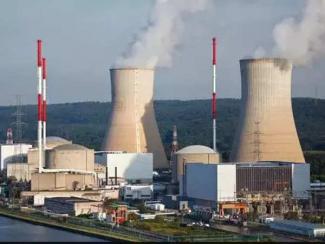Nuclear Energy is Back: Can it Stop Climate Change?
The world’s biggest economies are set to prepare for massive investments in nuclear energy. The most elusive energy, which was discarded in the 1992 Earth Summit as ‘not safe and sound’ energy, has been touted as the best alternative for the energy-crunch world in the recently concluded Group of Eight (G- 8) Summit meeting at St. Petersburg, Russia. After shock waves of the Three Miles and Chernobyl accidents, the nuclear energy is back to reduce the greenhouse gas emissions, the root cause of climate change. Moreover, Nuclear energy - earlier a classified national security concern, is now placed in an open international market for trade. Can massive nuclear energy expansion protect our climate?
Analyse this: In all OECD (Organisation for Economic Cooperation and Development) countries, 80 per cent of the public money for energy research projects in the last 50 years went to nuclear energy. The result: only five per cent of the energy in the world comes from nuclear sources. Between 1948 and 1998, the US government spent US $111.5 billion on energy research and development programmes. As much as 60 per cent, or US $66 billion, of this amount was spent on nuclear energy research. Now, the total nuclear energy production in 31 countries is over 364,000 MWe of total capacity, which is only 16 per cent of the world's electricity production. Simultaneously, all the OECD countries, the US being the largest, are the top emitter of greenhouse gases in the world.
While the leaders of the world's most industrialized nations endorsed the use of nuclear power during the Summit, they hinted at a disagreement with Germany. With Germany opposed to wider use of nuclear energy and the US refusing to sign the Kyoto Protocol, the leaders accepted that G-8 members pursue different ways to achieve energy security and the goals of climate protection. The statement on nuclear energy comes as G-8 leaders try to overcome disagreements about caps on greenhouse-gas emissions and focus on how to curb global warming without harming economic growth beyond 2012, when the current Kyoto Protocol expires. But, the fact remains that even countries go nuclear, the emission level is also increasing like in Japan. G-8 countries currently release 45 per cent of today's global green house emissions
On the other hand, renewable energy sector is growing like never before. For example, the wind energy sector has grown at more than 52 per cent per annum since 1971, and solar power by 32 per cent per annum. Now, the renewables are the second largest contributor to global electricity production, which is accounted for 20 per cent of production in 2005, after coal (39 per cent) but ahead of nuclear (16 per cent), natural gas (15 per cent) and oil (10 per cent).
The statement on nuclear power was a victory for French President Jacques Chirac, who has promoted the energy source as a clean alternative to oil. France, lacking in coal and oil, already has 58 nuclear reactors, the second-highest total in the world after the US, which has 104 and twice as many as Germany or the UK France gets more than three quarters of its electricity from nuclear energy, compared with about one third in Germany and one fifth in the US and UK.
However, the members were unanimous in backing Moscow’s plans to create international centers in Russia to produce nuclear fuel for countries with atomic power plants and a US plan to create a multilateral nuclear fuel bank. Experts argue that the Russian and American views are aimed at preventing those countries planning to develop their own nuclear programs, like Iran. The leaders strongly recommend that nuclear technology will be used only for energy generation, a condition that the US wants to be implemented as soon as possible.
While there are different views on implementing the Kyoto Protocol and nuclear energy, the leaders agreed to use nuclear technology as a source of energy on the condition of “openness and transparency.” The US is preparing to accept the first applications to build new nuclear reactors since the 1979 accident at the Three Mile Island plant in Pennsylvania.
Last year at Gleneagles Summit, Scotland, the G-8 countries asked the World Bank to prepare a plan for a global transition to a sustainable energy future that would support energy sector expansion towards the ultimate goals of economic growth and poverty reduction. The Summit mandated the World Bank to “take a leadership role in creating a new framework for clean energy and development”. In response to this mandate, in April this year, in Washington, the Development Committee, a senior decision-making body of the World Bank, discussed the World Bank proposal titled ‘Clean Energy and Development: Towards An Investment Framework'. This comprehensive report strongly advocates multilateral development banks lending for big hydropower projects and nuclear power to help reduce carbon emissions. The World Bank's new report acknowledges that just the cost of adapting to climate change is likely to be between 10 and 40 billion dollars per year. In the coming September annual meeting, the World Bank will lay the ground framework for fresh lending on nuclear energy.
Whether you like it or not, nuclear energy is now the focus for growing economies like India and China. According to official announcements, China will add 40,000 MW of nuclear power in the next 20 years, while India will add 20,000 MW. The presence of five big emerging market (BEM) countries in the G-8 summit signals the growing markets for nuclear energy. Although the growth of nuclear energy in India will be a maximum of 5-6 per cent at the end of the 15th Five-Year Plan (2032), the leaders are still begging for nuclear energy. If environmental costs are considered and subsidies on fossil fuels are removed, renewable technologies can compete with fossil fuel technologies and nuclear. Thus, much excitement about nuclear energy to reduce greenhouse gas emissions is a distant reality.
